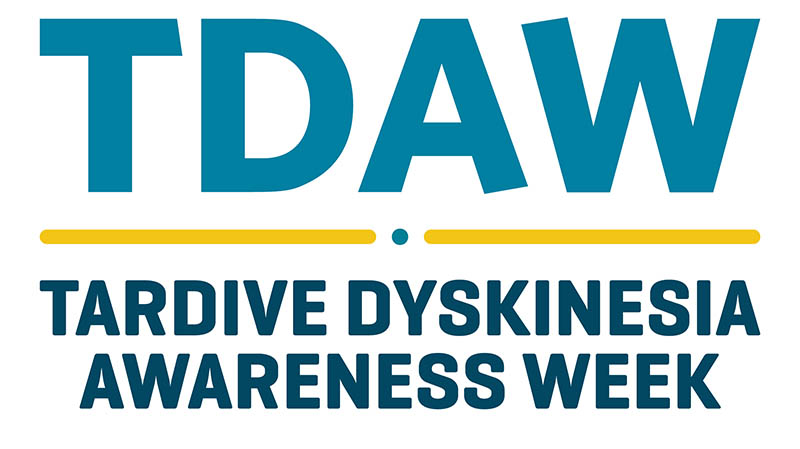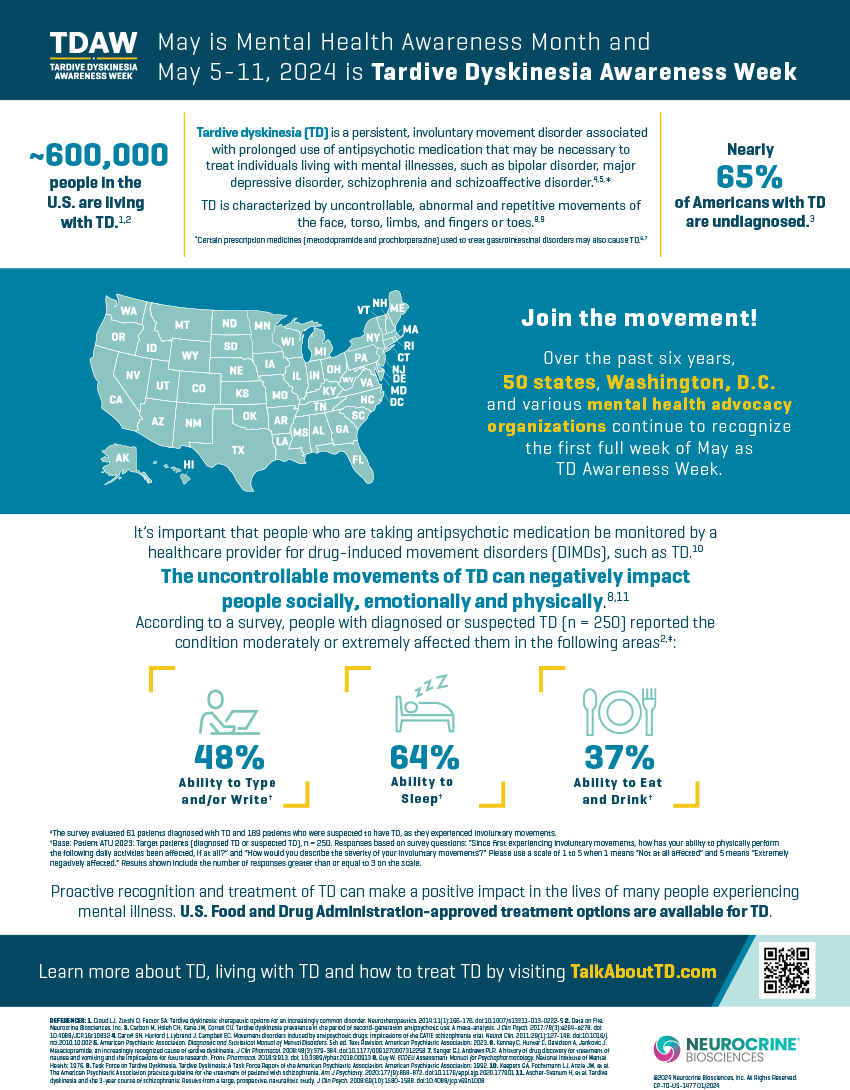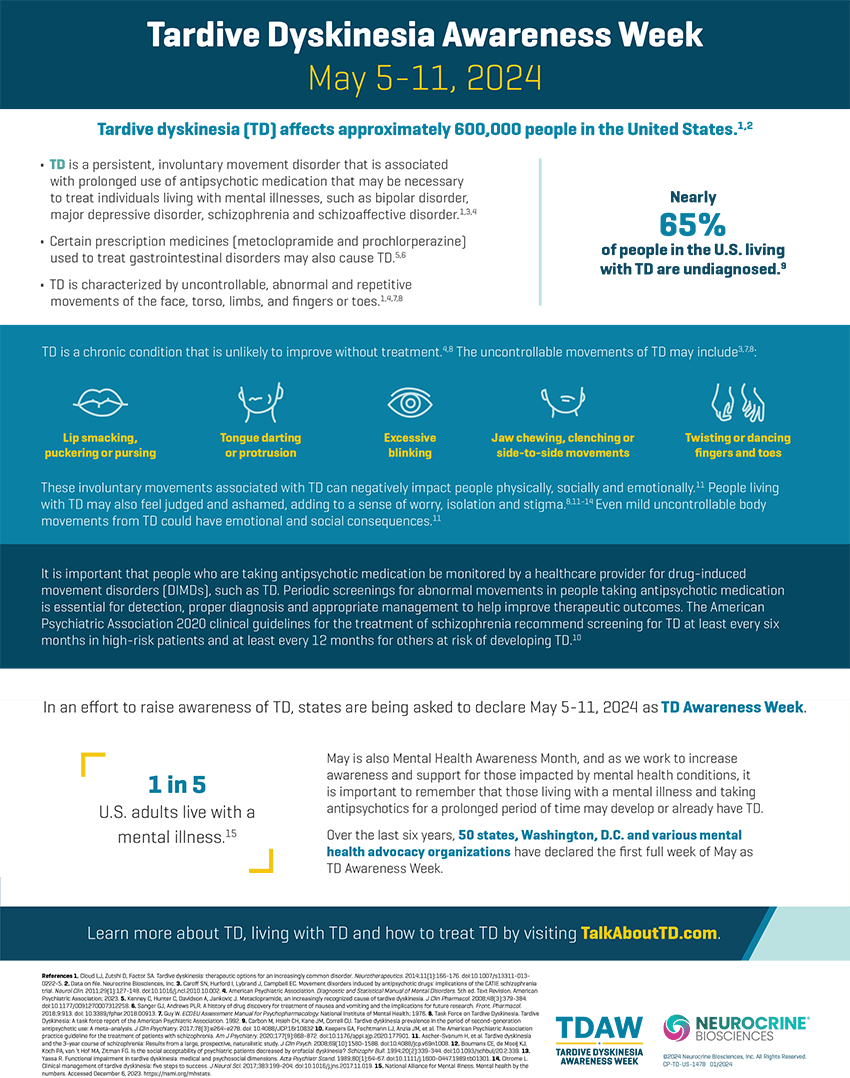TD Awareness
Tardive dyskinesia (TD) is a persistent, involuntary movement disorder that is characterized by uncontrollable, abnormal and repetitive movements of the face, torso, limbs and/or fingers or toes. TD is associated with prolonged use of antipsychotic medication that may be necessary to treat individuals living with mental illnesses, such as bipolar disorder, major depressive disorder, schizophrenia and schizoaffective disorder.

Neurocrine Biosciences Supports TD
Awareness
Week
 Neurocrine Biosciences is committed to bringing awareness to TD every day, but especially during Tardive Dyskinesia Awareness Week, recognized during the first full week of May. TD Awareness Week aims to help decrease stigma, improve recognition and increase routine screenings, diagnosis and awareness of appropriate treatment of TD.
Neurocrine Biosciences is committed to bringing awareness to TD every day, but especially during Tardive Dyskinesia Awareness Week, recognized during the first full week of May. TD Awareness Week aims to help decrease stigma, improve recognition and increase routine screenings, diagnosis and awareness of appropriate treatment of TD.
We aren’t the only ones who support this mission. Over the years, all 50 states, Washington, D.C. and various mental health advocacy organizations have declared the first full week of May as TD Awareness Week. To follow and join the conversation on social media, search for #TDAwarenessWeek and #Screen4TD.
Mental health continues to be a significant challenge in the United States, and it is important to include TD in the conversation because of the physical, social and emotional consequences this disorder can have on people trying to maintain mental health stability with antipsychotic medication.
The Impact of TD
There are approximately 600,000 people in the United States living with TD, and approximately 65% have not yet been diagnosed.
Involuntary movements associated with TD may be rapid and jerky or slow and writhing. TD is a chronic condition that is unlikely to improve without treatment. According to a survey, people with diagnosed or suspected TD (n = 250) reported the condition moderately or extremely affected them in the following areas‡:

64%
Ability to type and/or write†

64%
Ability to fall asleep†

37%
Ability to eat and drink†
People living with TD may also feel judged and ashamed, adding to a sense of worry, isolation and stigma. Even mild uncontrollable body movements from TD could have emotional and social consequences.# These movements can cause worry, frustration and self-consciousness.
Proactive recognition and treatment of TD can make a positive impact in the lives of many people managing their mental illness with antipsychotic medications. That’s why Neurocrine is committed to working with all segments of the healthcare system — patients, care partners, advocacy organizations, healthcare providers, government and public health officials — to advocate for routine screenings for TD as the standard of care for at-risk patients.
FAQs
What is TD?
TD is a persistent, involuntary movement disorder that is characterized by uncontrollable, abnormal and repetitive movements of the face, torso, limbs and/or fingers and toes. TD is associated with prolonged use of antipsychotic medication that may be necessary to treat individuals living with mental illnesses, such as bipolar disorder, major depressive disorder, schizophrenia and schizoaffective disorder.
Who is at risk for developing TD?
People living with a mental health condition, such as bipolar disorder, major depressive disorder, schizophrenia and schizoaffective disorder, who take necessary antipsychotic medication for a prolonged period of time may develop TD. Certain prescription medicines (metoclopramide and prochlorperazine) used to treat gastrointestinal disorders may also cause TD. Other factors may also play a role in an individual’s risk for TD:



Why is it important to prioritize TD awareness?
Despite the number of people impacted by the condition, many people remain unfamiliar with TD. However, for people living with TD, their families and their care partners, it is important to know that they are not alone. Approximately 65% of those living with TD in the U.S. have not yet been diagnosed. Increasing awareness will help more people to get diagnosed and receive the help they need.
When is TD Awareness Week?
TD Awareness Week is the first full week of May. May is also Mental Health Awareness Month, which brings attention to the one in five U.S. adults who lives with a mental illness. As we work to increase awareness and support for those impacted by mental health conditions, it is important to remember that those living with a mental illness and taking necessary antipsychotic medication for a prolonged period of time may develop or already have TD.
How many states have recognized TD Awareness Week?
All 50 states and Washington, D.C. have declared the first full week of May as TD Awareness Week.
Where can I learn more about TD?
To learn more about TD, living with TD and how to treat TD, visit TalkAboutTD.com. Healthcare professionals can visit MIND-TD.com for helpful information on identification of TD and differentiation from other movement disorders.




